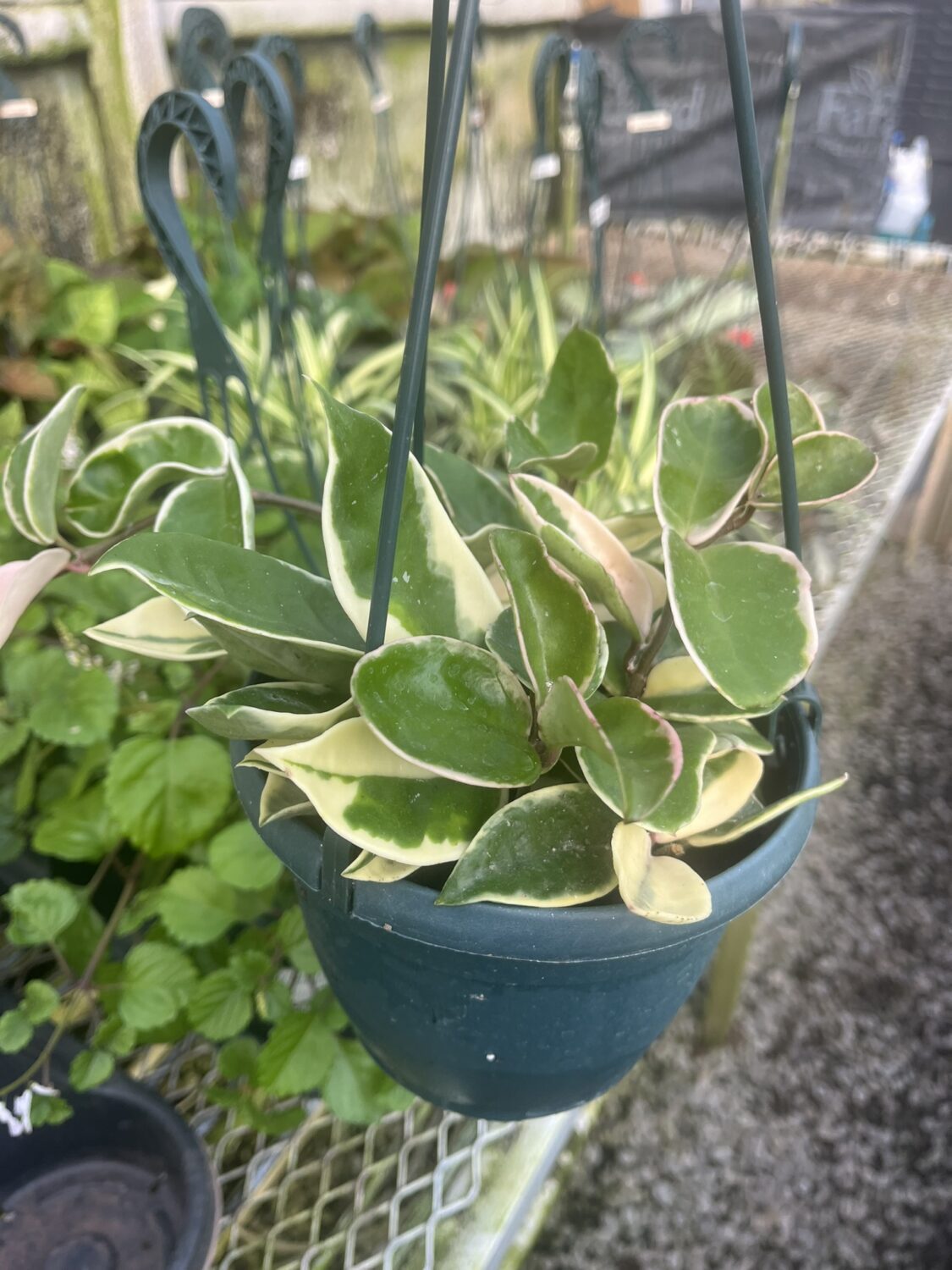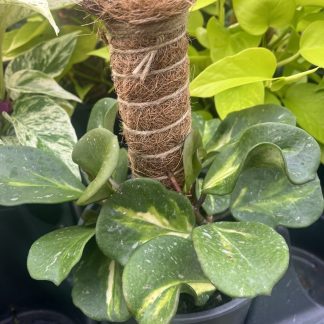Description
Hoya Carnosa ‘Krimson Queen’: Your Ultimate Guide to Growing and Loving This Beautiful Plant
Do you love plants with colorful leaves and an easygoing nature? Meet one of the most beloved houseplants in the world — the Hoya carnosa ‘Krimson Queen’. Also known as the Variegated Wax Plant, this tropical treasure is like a living work of art. Its glossy, tricolored leaves and cascading vines bring joy and calm to any home.
Whether you’re just starting your plant journey or you’ve been growing houseplants for years, the Krimson Queen is a must-have. It’s tough, beautiful, and long-lived. With just a little care and attention, it can thrive for decades and even reward you with clusters of sweet-smelling blooms.
Let’s dive into everything you need to know about this plant — from what makes it so unique to how to help it grow strong, vibrant, and, eventually, flower.
What Is Hoya Carnosa ‘Krimson Queen’?
The Hoya carnosa ‘Krimson Queen’ is part of the Hoya family, a group of tropical plants native to Southeast Asia and the Pacific Islands. Hoyas are commonly called wax plants because of their thick, glossy leaves and waxy, star-shaped flowers.
The Krimson Queen variety stands out for its dramatic variegation. Its leaves are edged with creamy white, blush pink, or soft yellow, while the centers remain rich green. Young leaves often emerge pure pink or white, adding an ever-changing splash of color to the plant. Over time, mature vines can trail four to six feet or more, making them perfect for hanging baskets, trellises, or decorative shelves.
And the blooms? When the plant is happy, it produces clusters of tiny star-shaped flowers called umbels. These flowers are pale pink with dark red centers and release a light, sweet fragrance, especially in the evening. They almost look like candy — and smell like it too.
Why the Krimson Queen Is So Special
Waxy, Colorful Foliage
The variegation is the star of the show. Each leaf feels like a polished work of nature — semi-succulent, shiny, and unique in pattern. No two vines look exactly the same. New growth often bursts out in bubblegum pink before maturing into white-edged green.
Fragrant, Starry Blooms
If cared for properly, your Krimson Queen may bloom after a few years. The clusters of tiny, starry flowers are fuzzy and candy-like, adding a magical touch to your home. Their soft fragrance fills the room in the evenings, creating a tropical vibe.
Easygoing Personality
This is a plant that doesn’t demand perfection. It tolerates missed waterings, adapts to most indoor conditions, and grows steadily without fuss. Treat it well, and it will reward you with beauty for decades.
How to Grow a Happy Hoya Krimson Queen
Ready to help your plant thrive? Here’s your step-by-step care guide.
1. Light: Bright but Gentle
Ideal light: Bright, indirect light.
Place your Krimson Queen near a window where sunlight is filtered. A north- or east-facing window is perfect. If you only have south- or west-facing windows, hang a sheer curtain to soften the light.
Too little light and the pink-and-white variegation may fade to green. Too much direct sun and the leaves can scorch. Like Goldilocks, the light needs to be just right.
Tip: If your plant is in low light and growth slows, consider adding a grow light to mimic natural sunshine.
2. Temperature and Humidity: Think Tropical
The Krimson Queen loves warmth. Ideal temperatures are 65–80°F (18–27°C). It will tolerate brief cooler spells but never let it dip below 50°F (10°C).
Humidity is also key. Aim for 50% to 70% humidity. If your air is dry — especially in winter — raise the moisture level by:
-
Using a humidifier
-
Grouping plants together to create a microclimate
-
Placing the pot on a tray filled with water and pebbles (keeping the pot above the water level)
Happy humidity equals lush growth and better chances of blooming.
3. Soil: Light and Well-Draining
Hoyas don’t like wet feet. They prefer soil that drains quickly but still holds a little moisture. Think airy and chunky, not dense.
Best mix options:
-
Use a pre-made cactus or succulent mix, or
-
Create your own blend:
-
1 part orchid bark
-
1 part perlite or pumice
-
1 part peat moss or coco coir
-
This mix mimics the plant’s natural habitat, where roots cling to trees and absorb rainwater without staying soggy.
4. Watering: Less Is More
Overwatering is the most common mistake with Hoyas. Their semi-succulent leaves store moisture, so they don’t need frequent watering.
Simple rule: Let the top 2–3 inches of soil dry out before watering again.
-
Water more often in spring and summer when the plant is actively growing.
-
Water less in fall and winter when growth slows.
Always use a pot with drainage holes to prevent root rot. And never let the plant sit in standing water.
5. Fertilizing: Light Feeding for Steady Growth
The Krimson Queen doesn’t need heavy feeding. During its active growing season (spring and summer), use a balanced, water-soluble fertilizer such as 10-10-10 or 20-20-20 every 4–6 weeks.
Want to encourage blooms? Switch to a fertilizer with a higher phosphorus (P) content during the blooming season.
Skip fertilizing in fall and winter — the plant rests then and won’t use extra nutrients.
6. Pruning and Cleaning: Keep It Tidy
Pruning helps your Hoya stay full and encourages branching.
-
Trim back long, leggy vines to promote bushier growth.
-
Remove yellow or damaged leaves as needed.
-
Wipe leaves gently with a damp cloth to keep them dust-free and shiny.
Important: Never cut off the flower stems (called peduncles) after blooming. Hoyas often rebloom from the same spot year after year.
7. Propagating: Multiply Your Collection
Want more Krimson Queens — or gifts for friends? Propagation is simple.
How to propagate:
-
Cut a vine 4–6 inches long with 2–3 nodes (the little bumps where leaves grow).
-
Remove the lower leaves to expose the nodes.
-
Place the cutting in water, moist soil, or sphagnum moss.
-
Keep it in bright, indirect light with extra humidity.
-
In 3–4 weeks, roots should form. Once they reach 1–2 inches long, plant the cutting in fresh soil.
Propagation success is high with Hoyas — patience is your only requirement.
8. Pests and Common Problems
The Krimson Queen is generally pest-resistant, but a few troublemakers may appear.
Watch for:
-
Mealybugs (white cotton-like clumps)
-
Spider mites (tiny dots and fine webbing)
-
Aphids (small green insects on new growth)
Solutions:
-
Wipe leaves with a damp cloth
-
Use insecticidal soap or neem oil spray
-
Quarantine new plants to prevent spreading pests
Common issues:
-
Yellow leaves: Overwatering
-
Drooping leaves: Underwatering or root problems
-
Brown tips: Low humidity or too much direct sun
Most problems are easily fixed with small adjustments to care.
9. Repotting: Slow and Steady
Hoyas like being slightly root-bound. Repot only when roots outgrow the pot or poke out of the drainage holes — usually every 2–3 years.
Repotting tips:
-
Choose a pot just one size larger.
-
Refresh with new, well-draining soil.
-
Water lightly after repotting to help roots settle.
Avoid frequent repotting, as it can delay blooming.
10. Encouraging Blooms
Patience is key. Hoyas may take several years to bloom, but when they do, the reward is worth it.
To encourage flowers:
-
Provide bright, indirect light year-round.
-
Keep the plant slightly root-bound.
-
Use a phosphorus-rich fertilizer in spring and summer.
-
Avoid cutting the peduncles where flowers appear.
When conditions are right, your Krimson Queen will surprise you with clusters of candy-like stars.
Why You’ll Fall in Love With This Plant
The Krimson Queen is more than a houseplant. It’s a living, evolving companion. Its vines grow slowly, marking time in your home. New leaves emerge in shades of pink and white, changing as they mature. And one day, when you least expect it, you’ll see the first cluster of waxy flowers — a quiet celebration of the care you’ve given.
It’s a plant that invites patience and rewards consistency. Perfect for plant lovers of all levels, it offers beauty without drama and joy without fuss.
Bringing the Krimson Queen Into Your Space
Ready to add this beauty to your collection? Place it in a bright spot, give it a chunky soil mix, water sparingly, and watch it grow. Over the months and years, it will trail gracefully, filling your space with soft color and tropical charm.
With minimal care and maximum impact, the Hoya carnosa ‘Krimson Queen’ is more than worth a spot in your home — it’s destined to become one of your favorites.
A Living Jewel That Keeps Giving
The Krimson Queen isn’t just a plant; it’s a relationship. It teaches patience, rewards attentiveness, and adds color and life to your daily routines. Whether you grow it for its leaves, its flowers, or simply for the joy of caring for something beautiful, this plant has a way of becoming part of the family.
If you’re looking for a houseplant that’s forgiving, gorgeous, and endlessly fascinating, the Krimson Queen might just be your perfect match.


